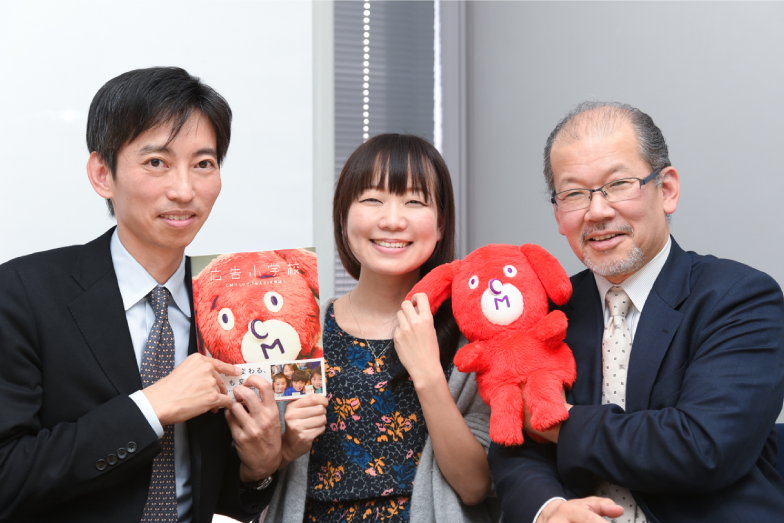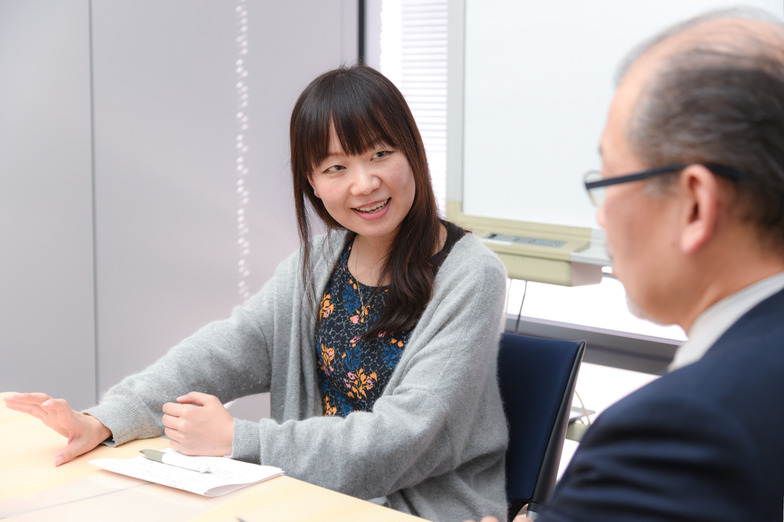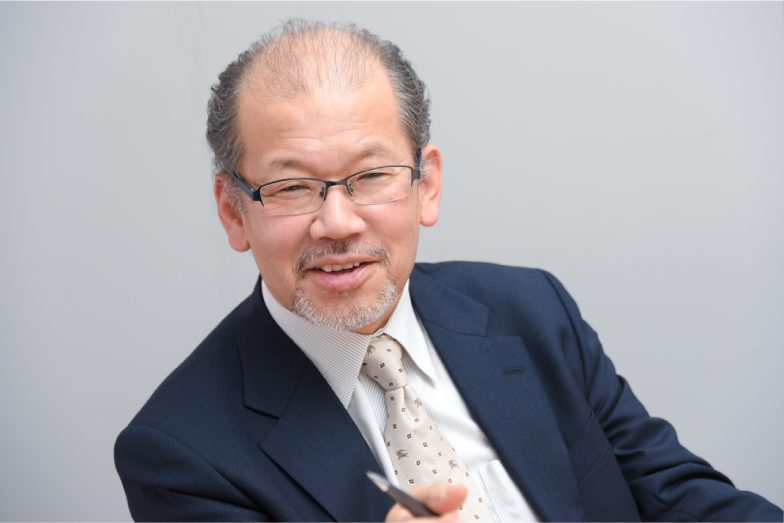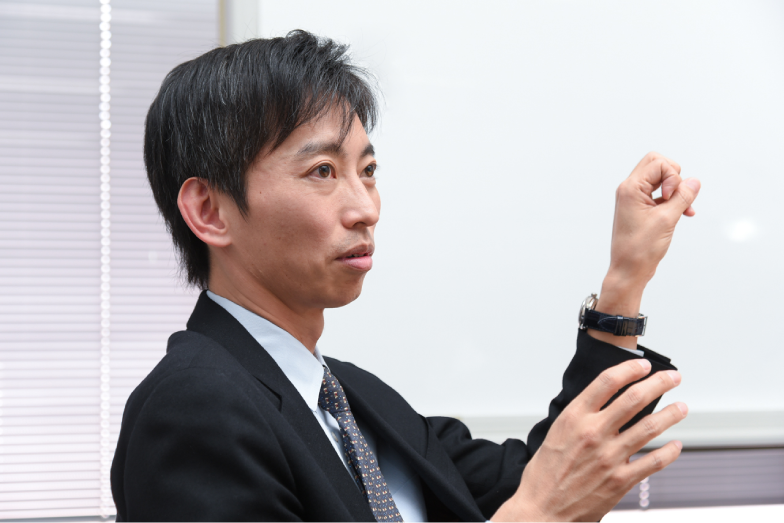To deepen an idea, the discussion shouldn't immediately jump to the means of expression – whether to "convey it through dance," "convey it through song," or "convey it with puns."
I said, "Before discussing methods, first decide on the core of the idea. You find defining that core difficult, so you skip it and jump straight to 'how to express it.'"
For example, if the concept for an ad about "super sweet chocolate" is distilled to "so sweet it changes your personality," then figuring out the execution afterward isn't that difficult.
Indeed, without a concept, problems arise. For instance, in meetings, the loudest person's expression method often gets decided. When someone says, "My idea is the best, right? Let's go with this," and the loudest voice prevails, everyone else feels empty. This results in 100% satisfaction for the loudest person and 0% for everyone else.
However, if you can gather everyone's ideas, establish a concept, and then expand on that concept, you can increase everyone's satisfaction with the final decision.
Makiguchi: That's absolutely right. At the Advertising Elementary School, some children initially sulked because their ideas weren't chosen, and some teachers, frustrated their ideas weren't accepted, would rush out the moment class ended. But by going through the process of thoroughly developing a concept, we created a system where everyone felt involved.
Tatebayashi: Concept development wasn't just a method of thinking; it was also a crucial process for how people interacted in group work, right?
The "Koma Dog" Failure Lowered the Bar
Tatebayashi: The Advertising Elementary School has a character called "Koma-inu." Initially, we planned to make Koma-inu the teacher. But that approach completely failed. It didn't create DVD materials that would really grab the children's attention. So, we revised the character's setting. We made it someone who learns alongside the children, just half a step ahead, and immediately fails – a somewhat unreliable personality.
I also voice Koma-inu, and during recording, Creative Director Motohisa Tanaka gave me strict direction: "Make it more pathetic! More foolish!" (laughs).
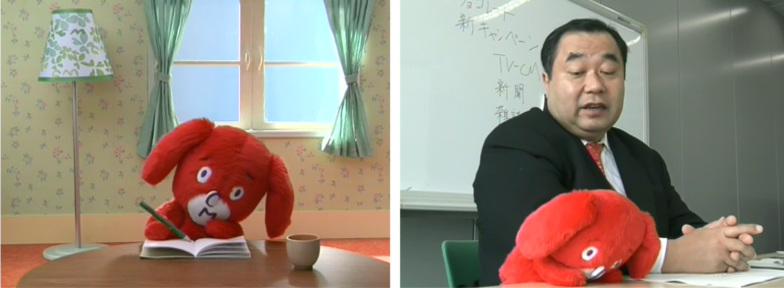
Koma-inu in the DVD teaching material. Struggling with making commercials, getting crushed by rejections from advertisers.
Okuma: When teaching, there's that moment when you think, "Today's lesson is going well." It's when you see the kids burst out laughing at Koma-inu's failures.
Tatebayashi: Koma-inu absolutely loves making commercials—so much so that his nose and mouth even spell out "CM." He gets commissioned by a company called ABC Corporation and proudly presents his own commercial ideas, only to get rejected every single time and get crushed.
Koma-inu goes "Gah!" The kids laugh. They relax. And then they think, "Okay, let's give it a shot."
For kids, coming up with ideas that don't have a single right answer takes courage, right? I think showing Koma-inu's big failures is a crucial point for lowering the hurdle when they're brainstorming.
Okuma: If the kids don't laugh at Koma-inu's failure, I adjust the lesson approach—like softening my tone when explaining.
Makiguchi: Koma-inu is like a litmus test. It shows whether the kids are relaxed and fully engaged. The most important thing is for them to feel comfortable coming up with ideas.
Ōkuma: That's right. At Advertising Elementary School, there are no set answers, so we should be able to make full use of all the children's free thinking. However, sometimes the teachers themselves hold them back.
When making commercials, one teacher probably thought their own ideas were better than the kids'.
They'd say things like, "This idea might be better," or "How about this one?" And it wasn't just one person.
Tatebayashi: Sometimes teachers steer the children toward their own ideas. When that happens, instead of thinking for themselves, the children try to find the "right answer" within the teacher.
Ōkuma: When teachers steer the children's conclusions toward their own preferences, the children's eyes glaze over. They end up presenting while sighing.
How do we counter that? The Dentsu Inc. person told us, "The lesson plan is flawed." That was the first time I'd ever heard that.
Makiguchi: The lesson plans we gave teachers—meant to be like a script for the class—were hard to follow.
Ōkuma: At one point, I looked at Dentsu Inc.'s event operation instructions. They were so clear that it was impossible to make mistakes. Even if the person in charge got sick and took a day off, anyone could step in with those instructions. So, I decided to incorporate that essence into the lesson plans.
As the Advertising Elementary School program spread, content varied widely across locations, and lessons tended to become disjointed. By reworking the lesson plans, we ensured they met standards wherever they were implemented.
The Weakening of Problem-Finding Skills
Okuma: Why is active learning gaining attention now? Because in modern times, there are no remaining challenges that can be solved by a single genius emerging.
Even Einstein couldn't solve the nuclear power plant problem. What's needed now is a collaborative approach where many people—nuclear experts, concrete specialists, water quality experts, soil scientists—contribute ideas and pool their knowledge.
Education that merely teaches pre-existing answers is no longer adequate for our times. What's needed now is the ability to generate ideas collectively for problems without clear-cut solutions. We also need versatile skills to apply what we learn in school to real-world situations and our own lives. Through activities like gathering diverse opinions within the Advertising Elementary School, synthesizing them, and delving deeper, both the teachers and students are learning active learning.

Makiguchi: Before even considering whether we can solve problems, the real issue now is the ability to identify problems in the first place.
Ōkuma: When I first became a teacher, I could simply hand out forms saying, "If you have a school problem, write it on this form," and gather various issues. Eventually, the children couldn't write down problems anymore, so I had to set aside time once a week for them to write. But now, even when I make time, they can't write them down.
Children who only receive instructions like "Do this" or "Do that" from teachers, and who have lost opportunities to discover problems, have become unable to identify issues and put them into words.
Tatebayashi: Within the Advertising Elementary School program, Unit 3's "Public Service Announcement" relates directly to this. It's a lesson where students discover societal problems and turn them into commercials. First, they use a "Discovery Notebook" to identify problems around them. Then, they use a "Solution Notebook" to devise their own solutions. Finally, they use an "Expression Notebook" to plan the commercial's message that communicates that solution.
Ōkuma: Exactly. That's the point. When creating public service commercials, we have the children identify the problem. The notebooks provide concrete methods for "how to find it." That was brilliant.
While teaching, I noticed something: the Discovery Notebook is red, the Solution Notebook is yellow, and the Expression Notebook is blue. It's just like traffic signals.

Tatebayashi: We designed it so stopping to discover is red, carefully considering the cause is yellow, and moving forward to communicate it to many people is blue.
Makiguchi: The crucial part is making discoveries in the red notebook. At this stage, teachers absolutely must not give unnecessary examples like "global warming." Children need the freedom to make their own discoveries.
To avoid creating active learning refugees
Ōkuma: Even when it comes to identifying problems, simply telling children to "think carefully" isn't enough. You must provide concrete thinking methods and approaches. If you tell kids to "think," but they can't, they get stuck there. That's an "active learning refugee." Merely telling children to "think carefully" or "discuss thoroughly" leads to failure.
Makiguchi: If we consider why the term "active" emerged, I think it's because learning was "passive" – that is, a passive activity. As Professor Okuma says, even though we call it active learning, it easily slips back into passive learning.
I recently read in a book by Takashi Saito that "new academic ability means discovering new meaning and value." We shouldn't just demand answers from children; we need them to think for themselves, make discoveries, and uncover new meaning and value. That's where the value of active learning lies.
The know-how to discover what doesn't exist
Makiguchi: Active learning boils down to "how to discover what doesn't exist." Until we start moving in 2020, when the education system undergoes major changes, we're still at the stage of organizing the issues and considering what can be done. Focusing on the Advertising Elementary School initiative within this context, we see that companies and schools are collaborating effectively.
Within Dentsu Inc., the unique qualities cultivated over time exist as "intangible knowledge." We want to leverage this, bringing companies and schools together through "industry-academia collaboration" to build the know-how for active learning.
Ōkuma: That's right. Traditional school education has focused on finding established answers, but the Advertising Elementary School has no predetermined solutions. Children need to learn new ways of using their brains.
Tatebayashi: Thank you. At the Active Learning "What About This?" Research Institute, we will systematize know-how applicable to active learning and propose it to schools. We plan to start projects with three research schools in Tokyo, listen to their challenges, and jointly develop active learning lessons tailored to each school.
Our core stance is "accepting everything." Since we're pursuing education without fixed answers, we don't want to impose a single tool. Instead, with a "What about this?" spirit, we aim to support the activation of learning.
Advertisement Elementary School
http://www.dentsu.co.jp/komainu/
DENTSU SOKEN INC. Active Learning "How About This?" Laboratory
http://dii.dentsu.jp/activelearning/






